BODYBUILDERS' CONTRIBUTION TO ECONOMY
Page 112
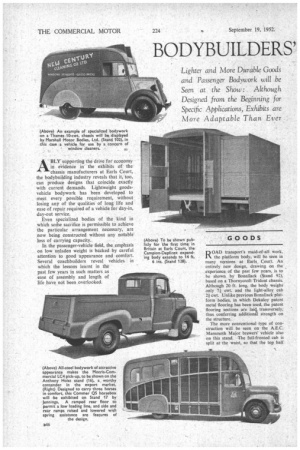
Page 113

Page 114
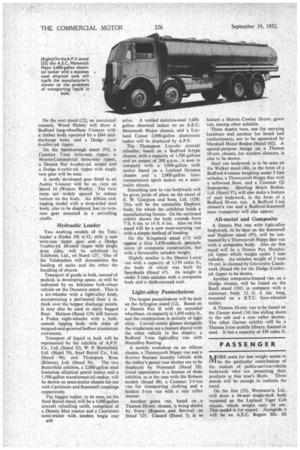
Page 117
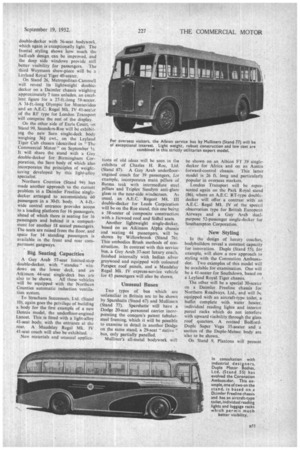
Page 118
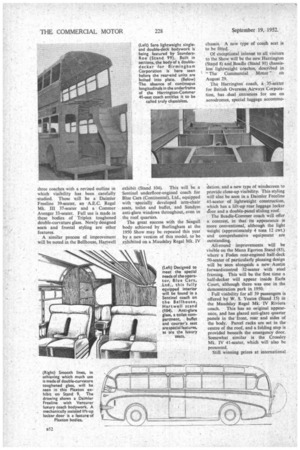
Page 119
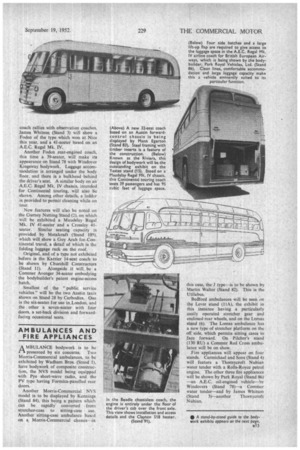
If you've noticed an error in this article please click here to report it so we can fix it.
ABLY supporting the drive for economy in evidenee in the exhibits of the chassis manufacturers at Earls Court, the bodybuilding industry reveals that it, too, can produce designs that coincide exactly with current demands. Lightweight goodsvehicle bodywork has been developed to meet every possible requirement, without losing any of the qualities of long life and ease of repair required of a vehicle for day-in, day-out service.
• Even specialized bodies of the kind in which sorhe sacrifice is permissible to achieve the particular arrangement necessary, are now being constructed without any notable' loss of carrying capacity..
In the passenger-vehicle field, the emphasis on low unladen weight is backed by careful attention to good appearance and comfort. Several coachbuilders reveal vehicles in which the lessons learnt in the past few years in such matters as ease of assembly and length of life have not been overlooked.
ROAD transport's maid-of-all work, the platform body, will be seen in many versions at Earls Court. An entirely new design, drawing on the experience of the past few years, is to he shown by Bonallack (Stand 92), based on a Thornycroft Trident chassis. Although 20 ft. long, the body weighs only 71 cwt. and the light-alloy cab 21 cwt. Unlike previous Bonallack platform bodies, in which Dekaloy patent metal flooring has been used, the patent flooring sections are laic], transversely, thus conferring additional strength on the structure.
The more conventional type of construction will be seen on the A.E.C. Mammoth Major brewers' vehicle also on this stand. The full-fronted cab is split at the waist, so that the top half can be removed for engine attention, whilst the windscreen panels are recessed in the framing to reduce glare.
Two containers, one for the transport of fish and the other for the transport of grain in bulk, will be other Bonallack exhibits.
Two containers are also to be displayed by Duramin Engineering Co., Ltd. (Stand 18), as well as a Maudslay Monarch Mk. III platform lorry. This is framed in Duralumin and incorporates Duraplank flooring. Sliding doors are fitted to the cab and the total weight of body and cab is 1l cwt.
A Guy Otter Diesel, an Albion Chieftain and a Seddon 3-tonner, all fitted
with platform bodies and all weighing under 3 tons unladen, are to be shown by Holmes (Preston), Ltd. (Stand 129). the Albion Chieftain is unusual in that curved corner panels of glass lie on e.ach side of the windscreen.
A six-wheeled platform lorry, based on an A.E.C. Mammoth Major chassis and intended for the transport of rolls of newsprint, is to be shown by Express Motor and Body Works, Ltd., on Stand 89.
Popular with overseas operators, hut not so frequently seen in this cOuntry, is the stake-sided body, an all-steel example of which, incorporating a new and particularly stiff form of floor construction, is to be exhibited by Anthony Hoists, Dd. (Stand 16). Based on a Morris-Commercial NVS 13/5 chassis,
this vehicle is fitted with the Anthony hydraulic tailboard loader, one of two of this type to be seen at the Show.
• Conventional types of dropilded body are to be displayed by the Express concern on a Commer 3-4-Ion chassis, and 'by a number of manufacturers of tipping gear. The biggest display of tipping vehicles will be on the stand of Edwards Bros. (Tippers), Ltd. (Stand 21). The largest of these is based on. a Thornycroft Trusty chassis and is operated by 3LN twin-front-ram ID-bin gear.
A Thornycroft Trusty will also be the centre-piece of the Anthony display, this vehicle being fitted with a steel dump body and the ST27 heavy-duty gear recently put into production by the concern.
Light-alloy Tippers Weighing only 19 cwt., a light-alloy body with a capacity of 231 cubic yds., mounted on an A.E.C. Mammoth Major chassis, will undoubtedly be the biggest tipper to be shown. It will be on the stand of Pilot Works, Ltd. (103), and it is claimed that a saving of 141 cwt., compared with a timber body, is possible with the light-alloy construction. _Another new Pilot product will be the Guy Otter dump truck, equipped with the 116 slant underbody gear arranged to give a 50-degree tilt.
Albion, Atkinson, Austin and Leyland chassis equipped with tipping gear made by the exhibitors, will appear on Stand 23 (Bromilow and Edwards, Ltd.). A combined power take-off and pump fitted to the Atkinson operates a sidetipping gear arranged to discharge logs on one side only. This is another special export model. On the next stand (22); an associated concern, Wood Hoists, will show a Bedford long-wheelbase 5-tonner with a timber body operated by a D64 enddischarge hoist, and a Dodge steel 6-cubic-yd. tipper.
On the Speiiborough stand (93), a•Commer 7-ton twin-ram tipper, a
Morris-Commercial three-way tipper, a Dennis Pax 6-cubic-yd. model and a Dodge 6-cubic-yd. tipper with single ram gear will be seen.
A newly'developed gear fitted to an Austin 5-tonner will be on view on Stand 14 (Weston Works). The twin rams are widely spaced to reduce torsion on the body. An Albion endtipping model with a -drop-sided steel body, also to be displayed, has its twinram gear mounted in a swivelling cradle.
Hydraulic Loader
Two working models of the Teleloader a Foden FE 6/12, with a new 'twin-ram tipper gear and a Dodge 5-cubic-yd. all-steel tipper with single drop sides, will be exhibited by Telehoist, Ltd., on Stand 127. One of the Teleloaders will demonstrate the loading of sacks and the other the handling of churns.
Transport of goods in bulk, instead of packed, is developing apace, as will be indicated by an Atkinson bulk-wheat vehicle on the Duramin stand. This is a six-wheeler with a light-alloy body, incorporating a perforated floor -I. in. thick over the hopper discharge points. It may also be used to carry bagged flour. Holmes (Stand 129) will feature a Foden eight-wheeler with a bulkcement tipping body with sides of tongued-and-grooved hollow aluminium extrusions.
Transport of liquid in bulk will be represented by the exhibits of A.P.V. Co., Ltd. (Stand 32), W. P:Butterfield, Ltd. (Stand 19), Steel Barrel Co., Ltd. (Stand 96), and Thompson BrOs.
(Bilston), Ltd. (Stand 56). The two Butterfield exhibits, a 2,000-gallon steel frameless elliptical petrol tanker and a 1,500-gallon transformer-oil tanker, will be shown on semi-trailer chassis for use with Carrimore and Scammell couplings respectively.
The biggest tanker, to be seen, on the Steel Barrel stand, will be a 4,000-gallon aircraft refuelling outfit, comprised of a Dennis Max tractor and a Carrimore semi-trailer with tandem bogie •rear B48 axles. A welded stainless-steel 3,600 gallon chemical tanker on an A.E.C. Mammoth Major chassis, arrd a Leyland Comet 2,000-gallon aluminium tanker will be displayed by A.P.V.
The Thompson Lincoln aircraft refueller, based on a Bedford S-type chassis, with a capacity of 1,500 gallons and an output of 200 g.p.m., is seen in company with a 3,000-gallon milk tanker based on a Leyland Octopus chassis and a 2,000-gallon fourcompartment spirit tanker on a semitrailer chassis.
Something new in van bodywork will be given 'pride of place on the stand of E. W. Campion and Sons, Ltd. (128). This will be the extensible Deplirex body, for which the exhibitor holds a manufacturing licence. On the sectioned exhibit shown the body extends from 7 ft. 6 ins. to 14 ft. 6 ins. Also on this stand will be a new meat-carrying van with a simple method of loading.
On the Kingsland stand (13) will appear a Guy 1,450-cubic-ft. pantechnicon of composite construction, but with a favourable unladen weight.
Slightly smaller is the Dennis Luton' van with a capacity of 1,150 cubic ft., the body of which was built by Sparshatts (Stand 67). Its weight is under 3 tons unladen with a composite body and a cloth-covered roof.
Light-alloy Pantechnicon
The largest pantechnicon will be seen on the Arlington stand (12). Based on a Dennis Pax II with an extended wheelbase, its capacity is 1,850 cubic ft., and the construction is entirely of light alloy. Curved corner glasses alongside the windscreen arc a feature shared with the other vehicle in the display, a Bedford 5-ton light-alloy van with Huntalloy flooring.
A mobile workshop on an Albion chassis, a Thornycroft Nippy van and a Karrier Bantam laundry vehicle with the maker's patent rear shutter are to be displayed by Normand (Stand 20). Good appearance is a feature of these exhibits, as is the case with the Robson models (Stand 88), a Commer 2-3-ton van for transporting clothing and a Seddon 3-ton van with a rear roller shutter.
Another gown van, based on a Thames 10-cwt. chassis, is being shown by Perry (Repairs and Service) on Stand 125. Cunard (Stand 7) is to feature a Morris Cowley 10-cwt. gown van, among other exhibits.
Three Austin vans, one for carrying furniture and another for bread and confectionery, are to be sponsored by Marshall Motor Bodies (Stand 102). A special-purpose design on a Thames 10-cwt. chassis, for window cleaners, is also to be shown.
Steel van bodywork is to be seen on the Walker stand (46), in the form of a Bedford 4-tonner weighing under 3 tons unladen, a Thornycroft Nippy Star with a softwood floor, and a Commer 02 Superpoise. 8-purling Motor Bodies. Ltd. (Stand 57), will also make a feature of steel bodywork, in the form of .a Bedford 30-cwt. van. A Bedford 5-ton cleaner's van and a Bedford-Scammell meat transporter will also appear.
All-metal and Composite
A Dennis Fax van with light-alloy bodywork, to be seen on the Scammell and Nephew stand (95), will be contrasted by a Thornycroft Nippy Star van with a composite body. Also on this stand will be a Dennis Fax 10-cubicyd. tipper which weighs under 3 tons unladen. An unladen weight of 2 tons 19 cwt. is claimed by University Coachwork (Stand 44) for the Dodge 6-cubicyd. tipper to be shown.
Another composite-framed van, on a Dodge chassis, will be found on the Reall stand (101) in company with a container body 12 ft. 6 ins, long, mounted on a B.T.C. four-wheeled trailer.
A Thames 10-cwt. van to be found on the Garner stand (34) has sliding doors to the cab and a rear roller shutter. The other Garner exhibit will be a Thames 2-ton mobile library, framed in steel. It has a capacity of 430 cubic ft.
PASSENGER
RAORE seats for less weight seems to IVI be the particular contribution of the makers of public-service-vehicle bodywork who are presenting their products at this year's Show. Three stands will be enough to indicate the trend.
On the first (25), Weyrnann's, Ltd., 'will show a 44-seat single-deck body mounted on the Leyland Tiger Cub chassis, which weighs only 36 cwt. This model is for export. Alongside it will be an A.E.C. Regent Mk. III double-decker with 56-seat bodywork, which again is exceptionally light. The frontal styling shows how much the half-cab design can be improved, and the deep side windows provide still better visibility for passengers. The third Weymann show-piece will be a Leyland Royal Tiger 40-seater.
On Stand 26, Metropolitan-Cammell will reveal its lightweight doubledecker on a Daimler chassis weighing approximately 7 tons unladen, an excellent figure for a 27-ft.-long 58-seater. A 34-ft.-long Olympic for Montevideo and an A.E.C. Regal Mk. IV 41-seater of the RF type for London Transport will comprise the rest of the display.
On the other side of Earls Court, on Stand 99, Saunders-Roe will be exhibiting the new Saro single-deck body weighing 361 cwt., on the Leyland Tiger Cub chassis (described in "The Commercial Motor" on September S), It will share the stand with a Guy double-decker for Birmingham Corporation, the Saro body of which also incorporates the principles of weight.saving developed by this light-alloy specialist:
Northern Counties (Stand 94) has made another approach to the current problem in a Daimler Freeline singledecker arranged to accommodate 60
passengers in a 30-ft. body. A 4-ft.wide central entrance provides access to a loading platform for 16 passengers, ahead of which there is seating for 16 passengers and behind it a compartment for another 18 seated passengers. The seats are raised from the floor, and space for 14 standing passengers is available in the front and rear compartment gangways.
Big Seating Capacities
A Guy Arab 57-seat Iimited.stop double-decker, with " standee " windows on the lower deck, and an Atkinson 44-seat single-deck bus are also to be shown. All these vehicles will be equipped with the Northern Counties automatic induction ventilation system.
To Strachans Successors, Ltd. (Stand 10), again goes the privilege of buildirig a body for the first example of a new Dennis model, the underfloor-engined Lancet. This is fitted with a light-alloy 41-seat body, with the entrance at the rear. A Maudslay Regal Mk. IV 41-scat coach will also be exhibited.
New materials and unusual applica
lions of old ideas will be seen in the exhibits of Charles H. Roe, Ltd. (Stand 87). A Guy Arab underfloorengined Coach for 39 passengers, for example, incorporates main pillars of Burma teak with intermediate steel pillars and Triplex Sundym anti-glare glass in the near-side windscreen. As usual, an A.E.C. Regent Mk. III double-decker for Leeds Corporation will be on the Roe stand, this one being a 58-seater of composite construction with a licwood roof and Sidhil seats.
Another lightweight single-decker, based on an Atkinson Alpha chassis and seating 44 passengers, will be shown by Willowbrook (Stand 76). This embodies Brush methods of construction. In contrast with this service bus, a Guy Arab 37-seat luxury coach, finished internally with Indian silver greywood and equipped with coloured Perspex roof panels, and a Maudslay Regal Mk. IV express-service vehicle for 43 passengers will also be shown.
Unusual Buses Two types of bus which are unfamiliar in Britain are to be shown by Sparshatts (Stand 67) and Mullinel-s (Stand 77). Sparshatts will have a Dodge 20-seat personnel carrier incorporating the concern's patent tubularsteel framing, which it will be possible to examine in detail in another Dodge on the same stand, a 29-seat " native " bus, only partially panelled.
Mulliner's all-metal bodywork will be shown on an Albion FT 39 singledecker for Africa and on an Austin forward-control chassis. This latter model is 26 ft. long and particularly popular in overseas markets.
London Transport will be represented again on the Park Royal stand (86), where an A.E.C. RT-type double'decker will offer a contrast with ark A.E.C. Regal Mk. IV of the special observation type for British European Airways and a Guy Arab dualpurpose 52-passenger single-decker for Southampton Corporation.
New Styling
In the design of luxury coaches, bodybuilders reveal a constant capacity for innovation. Duple (Stand 55), for example, will show a new approach to styling with the Coronation Ambassador. Two examples of this model will be available for examination. One will be a 41-seater for Southdown, based on a Leyland Royal Tiger chassis.
The other will be a special 30-seater on a Daimler Freeline chassis for Northern Roadways, Ltd., and will be equipped with an aircraft-type toilet, a buffet complete with water heater, individual reading lights and interior parcel racks which do not interfere with upward visibility through the glass roof quarters. A revised BedfordDuple Super Vega 35-seater and a section of the Duple-Metsec body are also to be shown.
On Stand 9, Plaxtons will present
three coaches with a revised outline in which visibility has been carefully studied. These will be a Daimler Freeline 39-seater, an -A.E.C. Regal Mk. III 37-seater and a Cornrner Avenger 33-seater. Full use is made in these bodies of Triplex toughened double-curvature glass. Newly designed seats and frontal styling are other features.
A similar process of improvement will be noted in the Belihouse, Hartwell exhibit (Stand 104). This will be a Sentinel underfloor-engined coach for Blue Cars (Continental), Ltd., equipped with specially developed arm-chair seats, toilet and buffet, and Sundym anti-glare windows throughout, even in the roof quarters. The great success with the Seagull body achieved by Burlingham at the 1950 Show may be repeated this year by a new version of this model, to be .e3thibited on a Maudslay Regal Mk. IV chassis. A new type of coach scat is to be fitted.
Of exceptional interest to all visitors to the Show will be the new Harrington (Stand 8) and Beadle (Stand 91) chassisless lightweight coaches, described in "The' Commercial Motor" on August 29.
The Harrington coach, a , 35-seater for British Overseas Airways Corporation, has dual entrances for use on aerodromes, special luggage accommo
*dation, and a new type of windscreen to provide close-up visibility l This styling will also be seen in a Daimler Freeline 4I-seater of lightweight construction, which has a lift-up rear luggage locker door and a double-panel sliding roof.
The Beadle-Commer coach will offer a contrast, in that its appearance is more conventional, although the light weight (approximately 4 tons 12 cwt.) and comprehensive equipment are outstanding.
All-round improvements will be visible on the Mann Egerton Stand (83), where a Foden rear-engined half-deck 50-seater of particularly pleasing design will be seen alongside a new Austin forward-control 32-seater with steel framing. This will be the first time a half-decker will appear inside Earls Court, although there was one in the demonstration park in 1950.
Full visibility for all 39 passengers is offered by W. S. Yeates (Stand 15) in the Maudslay Regal Mk. IV Riviera coach. This has an original appearance, and has glazed anti-glare quarter panels in the front, rear and sides of the body. Parcel racks are set in the centre of the roof, and a folding step is provided beneath the emergency door. Somewhat similar is the Crossley Mk. IV 41-seater, which will also be presented.
Still winning prizes at international coach rallies with observation coaches, James Whitson (Stand 3) will show a Foden of the type which won at Nice this year, and a 41-seater based on an A.E.C. Regal Mk. IV.
Another Foden rear-engined coach, this time a 39-seater, will make its appearance on Stand 78 with Windovcr • Kingsway bodywork. Luggage accommodation is arranged under the body floor, and there is a bulkhead behind the driver's seat. A similar body on an A.E.C. Regal Mk. IV chassis, intended for Continental touring, will also be shown. Among other details, a ladder is provided to permit cleaning while on tour.
New features will also be noted on the Gurney Nutting Stand (2), on which will be exhibited a Maudslay Regal Mk, IV 41-seater and a Crossley 41seater. Similar seating capacity is provided by Metalcraft (Stand 105), which will show a Guy Arab for Continental travel, a detail of which is the folding luggage rack on the roof.
Original, and of a type not exhibited before is the Karrier 14-seat coach to be shown by Churchill Constructors (Stand 11). Alongside it will be a Commer Avenger 34-seater embodying ' the bodybuilder's patent engine-access hatch.
Smallest of the "public service vehicles" will be the two Austin taxis shown on Stand 28 by Carbodies. One is the six-seater for use in London, and the other a seven-seater with four doors, a set-back division and forwardfacing occasional seats.
AMBULANCES AND FIRE APPLIANCES
AMBULANCE bodywork is to be presented by six concerns, Two Morris-Commercial ambulances, to be exhibited by Wadham Bros. (Stand 1), have bodywork of composite construction, the NVS model being equipped with Pye short-wave radio, and the PV type having Formica-panelled rear doors.
Another Morris-Commercial NVS model is to be displayed by Kennings (Stand 84), this being a pattern which can be rapidly' converted • from stretcher-case to sitting-case use. Another sitting-case ambulance based on a_ Morris-Commercial chassis— in this case, the I type—is to be shown by Martin Walter (Stand 82). This is the Utilabus.
Bedford ambulances will be seen on the Lever stand (11A), the exhibit in this instance having a particularly easily operated stretcher gear and enclosed rear wheels, and on the Lomas stand (6). The Lomas ambulance has a new type of stretcher platform on the off, side, which permits sitting cases to face forward, On Pilcher's stand (130 RU) a Commer Red Cross ambulance will be on show.
Fire appliances will appear on four stands, Carmichael and Sons (Stand 4) will feature a Thornycroft Nubian water tender with a Rolls-Royce petrol engine. The other three fire appliances will be shown by Park Royal (Stand 86) —an A.E.C. oil-engined vehicle—by Windovers (Stand 78)—a Commer water tender—and by James Whitson (Stand 3)—another Thornycroft Nubian.




































































































































































